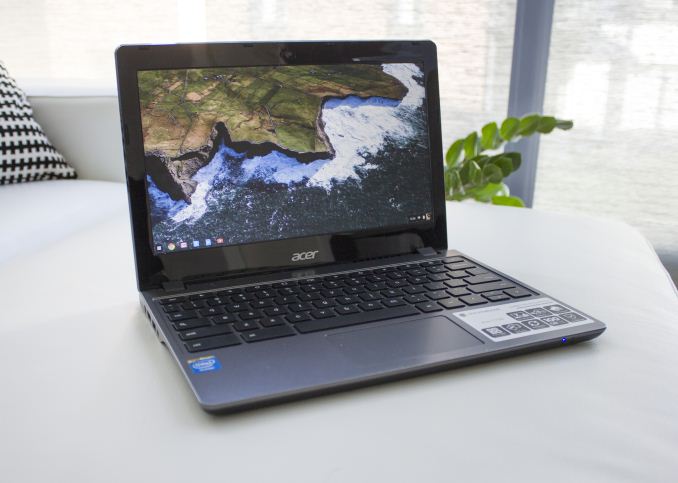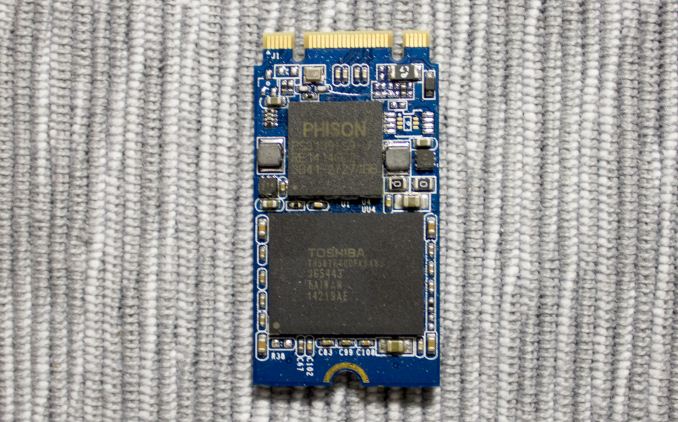Upgrading the SSD in Chromebook & MyDigitalSSD Super Boot Drive M.2 2242 SSD Review
by Kristian Vättö on October 21, 2014 8:00 AM EST
While the whole netbook boom kind of died with the introduction of tablets, Chromebooks have been gaining more and more traction recently. The original Windows netbooks failed to provide a smooth user experience due to the lack of operating system optimization, and Windows was simply way too heavy to be run with such limited resources. Chrome OS on the other hand was designed specifically for netbook-like devices. Google took a totally different approach by designing the Chrome OS around web and cloud-based services, which allowed the OS to be run with very little onboard storage.
Most of today's Chromebooks actually ship with either a small mSATA/M.2 SSD or have an eMMC package onboard, which is a bit ironic since Chromebooks are generally the cheapest laptops around, yet if you buy a Windows laptop that costs twice as much you will most likely end up with a traditional hard drive for storage. That is an enormous benefit that Chromebooks have because the lack of a hard drive enables much thinner and lighter designs, which translates into a better user experience.
The majority of the Chromebooks have 16GB of onboard storage with some high-end models having twice that. For the intended usage where everything is done in the web, that is sufficient, but when you need local storage for offline occasions (e.g. when traveling), 16GB or 32GB will not get you far. There is always the option of carrying external storage to expand the internal storage, but there is another alternative: upgrading the internal SSD.
For the purpose of this review, MyDigitalSSD sent us a 256GB Super Boot Drive in M.2 2242 form factor along with Acer's C720-2848 Chromebook.
| Acer C720-2848 Chromebook Specifications | |||||||||
| Display | 11.6" 1366x768 | ||||||||
| Processor | Intel Celeron 2955U (2/2, 1.4GHz, 2MB, 15W) | ||||||||
| Graphics | Intel HD Graphics (200MHz, 1GHz max Turbo) | ||||||||
| Memory | 2GB DDR3 | ||||||||
| Storage | 16GB SSD (M.2 2242) | ||||||||
| Connectivity | WiFi (802.11 a/b/g/n), Bluetooth 4.0, 1x USB 3.0, 1x USB 2.0, SD card reader, 1x HDMI | ||||||||
| Dimensions | 11.34" x 8.03" x 0.78" (W x D x H) | ||||||||
| Weight | 2.98lb | ||||||||
The C720 is what you would expect a Chromebook to be. The display is a bad TN panel, the trackpad does not always feel responsive, and the overall build is just plastic. It feels cheap, but the positive thing is that it really is cheap, as the C720-2848 currently retails for just $200. I cannot really give an objective review of the laptop itself as I have not used any other Chromebooks, but overall I am fairly impressed with what $200 gets you nowadays.
| MyDigitalSSD Super Boot Drive M.2 2242 Specifications | |||||||||
| Capacity | 8GB | 16GB | 32GB | 64GB | 128GB | 256GB | |||
| Controller | Phison S9 (PS3109) | ||||||||
| NAND | Toshiba A19nm MLC | ||||||||
| Sequential Read | Up to 545MB/s | ||||||||
| Sequential Write | Up to 410MB/s | ||||||||
| Warranty | Three years | ||||||||
Like other MyDigitalSSD's SSDs, the Super Boot Drive is based on a Phison controller and comes in a variety of capacities. The M.2 2242 currently tops out at 256GB since the form factor limits the number of NAND packages to two, and with 16GB die 128GB packages are the biggest that are available in the open market.
Notice that there is no DRAM at all. The M.2 2242 form factor lacks the space for a dedicated DRAM chip, so the NAND mapping table and host IO caching is done in the internal caches of the controller (usually a few megabytes of SRAM). There is a bit of a performance penalty from doing that as the internal caches are much smaller, but it is the only viable way to squeeze a full SSD into such small area.
Test Systems
There are two major items we want to look at in this review: first, we want to investigate the upgrade procedure for the Acer C720 Chromebook and examine Chrome OS performance, and second we're going to look at the MyDigitalSSD Super Boot Drive as a standard SSD and run our usual storage tests. For AnandTech Storage Benches, performance consistency, random and sequential performance, performance vs. transfer size and load power consumption we use the following system:
| CPU | Intel Core i5-2500K running at 3.3GHz (Turbo & EIST enabled) |
| Motherboard | ASRock Z68 Pro3 |
| Chipset | Intel Z68 |
| Chipset Drivers | Intel 9.1.1.1015 + Intel RST 10.2 |
| Memory | G.Skill RipjawsX DDR3-1600 4 x 8GB (9-9-9-24) |
| Video Card | Palit GeForce GTX 770 JetStream 2GB GDDR5 (1150MHz core clock; 3505MHz GDDR5 effective) |
| Video Drivers | NVIDIA GeForce 332.21 WHQL |
| Desktop Resolution | 1920 x 1080 |
| OS | Windows 7 x64 |
Thanks to G.Skill for the RipjawsX 32GB DDR3 DRAM kit
For slumber power testing we used a different system:
| CPU | Intel Core i7-4770K running at 3.3GHz (Turbo & EIST enabled, C-states disabled) |
| Motherboard | ASUS Z87 Deluxe (BIOS 1707) |
| Chipset | Intel Z87 |
| Chipset Drivers | Intel 9.4.0.1026 + Intel RST 12.9 |
| Memory | Corsair Vengeance DDR3-1866 2x8GB (9-10-9-27 2T) |
| Graphics | Intel HD Graphics 4600 |
| Graphics Drivers | 15.33.8.64.3345 |
| Desktop Resolution | 1920 x 1080 |
| OS | Windows 7 x64 |
- Thanks to Intel for the Core i7-4770K CPU
- Thanks to ASUS for the Z87 Deluxe motherboard
- Thanks to Corsair for the Vengeance 16GB DDR3-1866 DRAM kit, RM750 power supply, Hydro H60 CPU cooler and Carbide 330R case












67 Comments
View All Comments
phoenix_rizzen - Tuesday, October 21, 2014 - link
Where's the 13th screw? I only count 12. Or is there one underneath the "warranty is void" sticker?Kristian Vättö - Tuesday, October 21, 2014 - link
Yeah, it's under the sticker. I.e. you have to break the sticker in order to take the bottom off, so there goes the warranty.phoenix_rizzen - Tuesday, October 21, 2014 - link
Ah. Sneaky bastards. :)DIYEyal - Tuesday, October 21, 2014 - link
I have the C720 running debian on a 128GB MyDigitalSSD and I'm pretty satisfied, the only complaint I have was the soldered RAM (can't upgrade to 4GB)quagga - Wednesday, October 22, 2014 - link
Yeah, I'm typing this on mine running Arch on the default SSD. I can't see upgrading the HD when I really feel the ram is the bottleneck on the system. Enabling zram helps a little on the ram front and switching to BTRFS and enabling lzo got me back a bit of SSD space.HeavensInMotion - Tuesday, October 21, 2014 - link
Out of curiosity, how much of your Google Drive space is full? I suspect, but haven't been able to confirm, that ChromeOS will cache some of your drive on the chromebook. It may be based on recent usage, or important/starred documents, but I suspect that's where the 'lost' space on the new SSD went.
tuxRoller - Wednesday, October 22, 2014 - link
By default, ext4 reserves 5% of the filesystem for root use (there's also also various options that can take up a few more percent of space like inode size/xattrs, extra superblocks, etc). So, there's ~10GB. I believe that chromeos also keeps a master copy of itself so the system can be reset (not sure where this is stored, however).tuxRoller - Wednesday, October 22, 2014 - link
Yeah, never mind. I see that you installed windows on this.You really need to make your test suite xplatform.
cylemmulo - Wednesday, October 22, 2014 - link
I have zero clue why chromebooks are so popular. I tried one and it was laughably basic compared to windows systems that are now pretty much priced the same. This might be ok, but for its simplicity, chrome doesn't really run any faster than its Windows counterparts, nor does it get much better battery life at all. I just see no reason unless you just absolutely detest windows 8.Michael Bay - Wednesday, October 22, 2014 - link
Same reason iPad is. Simple machine for the crowd that wants to watch something and browse in one tab. PCs weren`t really made for this sector of the market anyway, function-wise or price-wise, so of course they went out.Try, say, to open up a real spreadsheet on those and it`s a completely different picture of course.